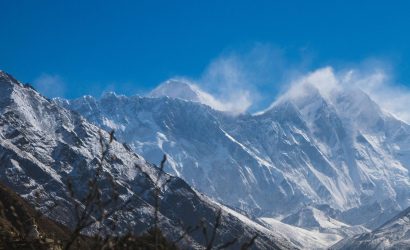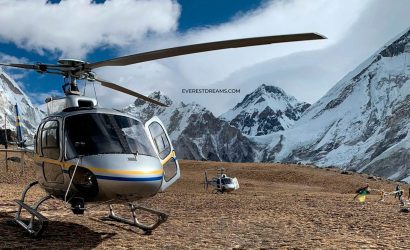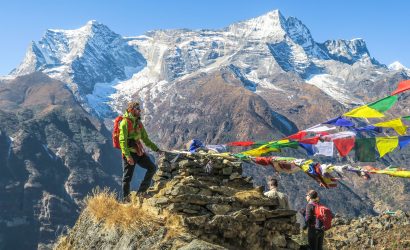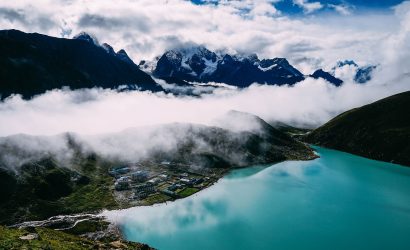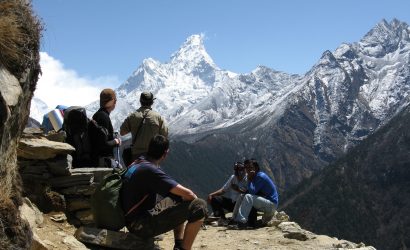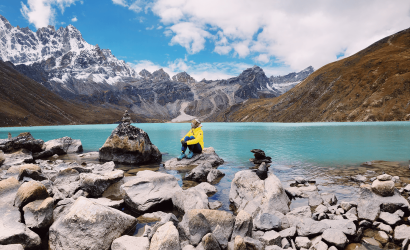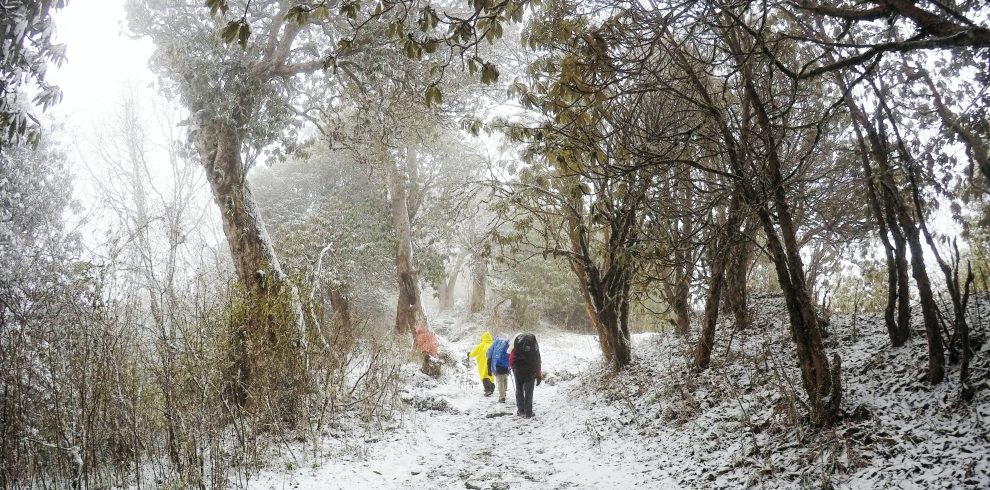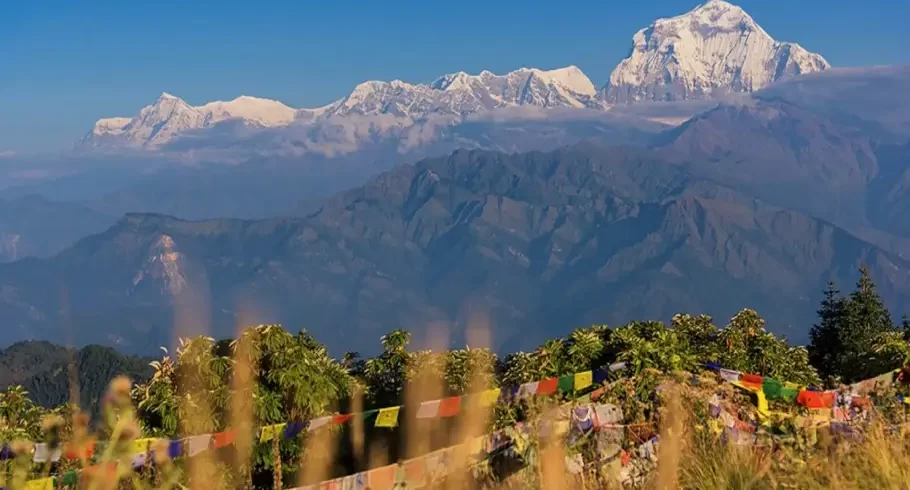-
Bus, Airlines
-
3 Stars Accommodation in City & Guest House During Trek
-
Ama Dablam Base Camp (4,575 meters)
-
Kathmandu
-
Feb, Mar, Apr & May
-
Trekking
-
All meals during the trek
-
English, Spanish, French, Chinese
-
Easy to Moderate
-
2-15
-
12
-
65
Overview
The Ama Dablam Base Camp Trek offers a thrilling adventure through the remote and breathtaking Khumbu region. With the main peak reaching 6,812 meters, this picturesque mountain provides unparalleled views of the world’s highest peaks.
Along the trek, you’ll visit Buddhist villages and monasteries, immersing yourself in the Sherpa lifestyle and traditions. Starting from Lukla, the gateway to Everest, you’ll explore Namche Bazar and Khumjung, witnessing majestic Himalayan panoramas.
Traversing ancient trails, you’ll reach the base camp of Ama Dablam, surrounded by stunning icefalls, glaciers, and peaks. After soaking in the awe-inspiring beauty, you’ll retrace your steps and return to Kathmandu.
Embark on this extraordinary journey with the Everest Dreams for an unforgettable experience of nature and culture in the Khumbu region.
Highlights
- Witness the majestic Ama Dablam peak and its stunning surroundings.
- Immerse yourself in Sherpa culture and traditions, visiting Buddhist villages and monasteries.
- Enjoy unparalleled views of the world's highest peaks, including Lhotse and Nuptse.
- Trek through remote and unspoiled trails, experiencing the beauty of the Khumbu region.
- Explore the base camp of Ama Dablam, surrounded by breathtaking icefalls, glaciers, and peaks.
Itinerary
Cost
Cost Includes
- All airport/hotel pick up and drop in private car/van
- 3 Nights Acommodation in Kathmandu including breakfast, Twin sharing 3*
- 8 Nights stay in Lodge/Guest House during the trek.
- An experienced English speaking Trekking Guide and a Porter during the trek.
- Salary, food, insurance, and lodging cost for guide and porter ( 2 Trekkers-1 Porter )
- During the Trek, we will have Breakfast, Lunch, Dinner and Tea/Coffee each time only.
- Welcome and Farewell Meals and Breakfasts while in Kathmandu.
- National Park Permit and TIMS for Everest.
- Airfare from Kathmandu to Lukla and return flight to Kathmandu and domestic flight departure taxes.
- Down Jacket and Sleeping Bag that needs to be returned to office after trek completion.
- Everest Dreams Kitbag and T- shirt for you.
- Kathmandu Valley city tour with guide, Including entrance fees.
- Ncell Sim Card (Nepalese Sim Card including 20 GB data pack) - Only 1 for a group.
Cost Excludes
- Nepal entry visa fees.
- International airfare and departure tax.
- Bar bills, laundry, and other expenses of personal nature.
- Travel insurance including evacuation.
- Lunch and dinner in Kathmandu except welcome and farewell.
- Tips for local staff, guides, and porters.
- Desserts, Hot Shower, Hot Water, Wi-Fi, Mineral Water.
FAQs
The best season for trekking to the Everest region is during autumn and spring, the months of September, October, November, March, April, and May.
During the autumn season, the months of September, October, and November the weather is clear with warm temperatures and the visibility is great. As the weather is mild it is very easy to get around the region.
The spring season of March, April, and May are also the best time to visit the Everest region, marking the end of the winter, the spring season brings a change in the topography of the region and the destination comes to life with endless rows of different colored rhododendron, moss and orchid draped trees, colorful undergrowth stretching for miles and the snowy white mountains peaks on the backdrop of clear blue skies.
Monsoon season is not favorable for trekking as the weather gets harsh and it is hard to get around the country with frequent landslides and floods. So usually, monsoon season is avoided by trekkers.
In the winter season, the area receives a high amount of snowfall, covering most of the trail, and access is denied to most of the regions of Everest, making it impossible to trek.
The trek requires two permits:
1) Sagarmatha National Park Entry Permit.
2) Khumbu Rural Municipality Entrance Permit.
The Nepal Tourism Boards office in Kathmandu or the park’s entrance gate in Monjo can provide you with Sagarmatha National Park Entry Permit for NRS 3000.
The fee for citizens of SAARC nations is NRS 1500.
You must complete the permit application and present your passport or a copy of your passport. You must be in Lukla to obtain the Khumbu Pasang Lhamu Rural Municipality Entrance Permit. The permission costs NRS 2000 and may be acquired at the rural municipality counter on the outskirts of the settlement.
You will not have to worry about waiting for permits since the Everest Dreams team will take care of everything.
In brief, the trails are long, harsh, and with high cliffs and mountain terrains which is why trekkers need to be more prepared.
Thus, you must have strong physical and mental fitness, to withstand the difficulties in trekking. In addition, train your body hard enough so that it can resist pressure and frequently changing terrains.
Travel Insurance:
All clients participating in any activity must have travel insurance. Personal injury, death, hospital expenditures, repatriation fees, helicopter rescue, and any other disease covered by the insurance plan will be given, we highly advise you to acquire a comprehensive insurance plan from a trustworthy insurance company.
Passport and Visa:
Every client must have a valid passport from the return date with a 6 months prior validity by the Nepalese consulate in your country or the immigration office at Tribhuvan International Airport in Kathmandu.
Accommodation:
Accommodations are available in trekking lodges, teahouses, and several hotels all along the trail, providing basic, well-maintained, reasonably luxury 5-star ones with additional needs according to your budget. Tea houses on the trail vary in quality and price, depending on the amenities they feature.
The tea houses room has twin sharing beds and some basic furniture like a table or a chair. Normally, beds contain pillows and sheets and almost all tea houses provide extra blankets as it will be freezing at night. Usually, hot showers are available throughout the trek.
For trekkers who want to Camp, various campsites are available along the trail.
Transportations:
All the necessary transportation for your trip will be managed by us upon your request. Transportation is provided on a private as well as sharing basis. Solo travelers are provided with sharing or public transportation. Whereas travelers of two and above are provided with private transportation.
Potter and Guide:
Solo trekkers are provided with a single helper both acting as a Potter and Guide. For trekkers above two or more Potters and Guides are provided according to the size of the groups. Every two guest is provided with one potter.
Responsible Tourism:
As responsible for tourism we believe in respecting local communities, their culture, and rules. So, for that region, we would like you to follow some local rules and regulations during the trek. Always ask your guides for permission before doing something in the local community. Keep the environment clean. Help the local community to encourage the positive sides of tourism.


